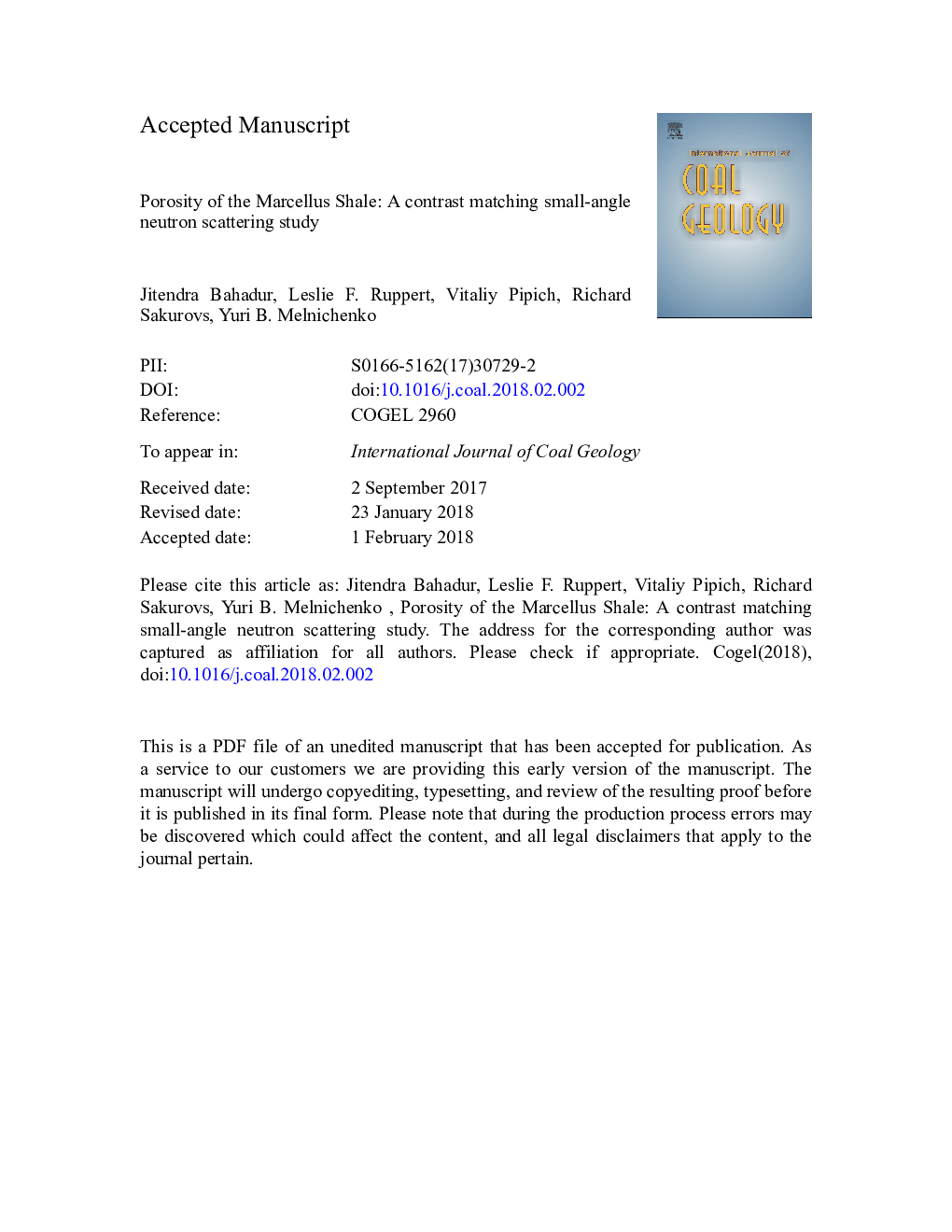| کد مقاله | کد نشریه | سال انتشار | مقاله انگلیسی | نسخه تمام متن |
|---|---|---|---|---|
| 8123541 | 1522515 | 2018 | 32 صفحه PDF | دانلود رایگان |
عنوان انگلیسی مقاله ISI
Porosity of the Marcellus Shale: A contrast matching small-angle neutron scattering study
ترجمه فارسی عنوان
تخلخل مارسلول شیل: یک مقایسه تطبیق پراکندگی نوترون با زاویه ناهموار
دانلود مقاله + سفارش ترجمه
دانلود مقاله ISI انگلیسی
رایگان برای ایرانیان
کلمات کلیدی
موضوعات مرتبط
مهندسی و علوم پایه
علوم زمین و سیارات
زمین شناسی اقتصادی
چکیده انگلیسی
Neutron scattering techniques were used to determine the effect of mineral matter on the accessibility of water and toluene to pores in the Devonian Marcellus Shale. Three Marcellus Shale samples, representing quartz-rich, clay-rich, and carbonate-rich facies, were examined using contrast matching small-angle neutron scattering (CM-SANS) at ambient pressure and temperature. Contrast matching compositions of H2O, D2O and toluene, deuterated toluene were used to probe open and closed pores of these three shale samples. Results show that although the mean pore radius was approximately the same for all three samples, the fractal dimension of the quartz-rich sample was higher than for the clay-rich and carbonate-rich samples, indicating different pore size distributions among the samples. The number density of pores was highest in the clay-rich sample and lowest in the quartz-rich sample. Contrast matching with water and toluene mixtures shows that the accessibility of pores to water and toluene also varied among the samples. In general, water accessed approximately 70-80% of the larger pores (>80â¯nm radius) in all three samples. At smaller pore sizes (~5-80â¯nm radius), the fraction of accessible pores decreases. The lowest accessibility to both fluids is at pore throat size of ~25â¯nm radii with the quartz-rich sample exhibiting lower accessibility than the clay- and carbonate-rich samples. The mechanism for this behaviour is unclear, but because the mineralogy of the three samples varies, it is likely that the inaccessible pores in this size range are associated with organics and not a specific mineral within the samples. At even smaller pore sizes (~<2.5â¯nm radius), in all samples, the fraction of accessible pores to water increases again to approximately 70-80%. Accessibility to toluene generally follows that of water; however, in the smallest pores (~<2.5â¯nm radius), accessibility to toluene decreases, especially in the clay-rich sample which contains about 30% more closed pores than the quartz- and carbonate-rich samples. Results from this study show that mineralogy of producing intervals within a shale reservoir can affect accessibility of pores to water and toluene and these mineralogic differences may affect hydrocarbon storage and production and hydraulic fracturing characteristics.
ناشر
Database: Elsevier - ScienceDirect (ساینس دایرکت)
Journal: International Journal of Coal Geology - Volume 188, 1 March 2018, Pages 156-164
Journal: International Journal of Coal Geology - Volume 188, 1 March 2018, Pages 156-164
نویسندگان
Jitendra Bahadur, Leslie F. Ruppert, Vitaliy Pipich, Richard Sakurovs, Yuri B. Melnichenko,
